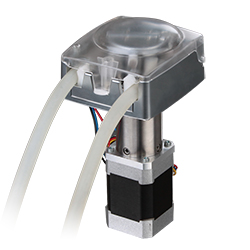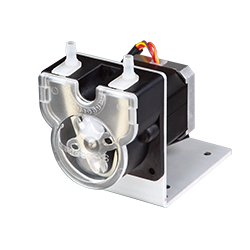OEM Peristaltic Pump in Dialysis Machine

Application Introduction:
In medicine, dialysis is a process for removing waste and excess water from the blood and is used primarily as an artificial replacement for lost kidney functions in people with kidney failure. The two main types of dialysis are hemodialysis and peritoneal dialysis; both remove waste and excess water from the blood but in different ways. Hemodialysis removes waste and water by circulating blood outside the body through an external filter, called a dialyzer, which contains a semi-permeable membrane. In peritoneal dialysis, waste and water are removed from the blood inside the body using the peritoneum as a natural semi-permeable membrane. The wastes and excess water are removed from the blood, across the peritoneal membrane, and into the dialysate, which is in the abdominal cavity. Dialysis machines are artificial kidneys that perform most, but not all, kidney functions for patients who have permanent or temporary renal failure. To protect the patient against adverse events that may arise from equipment malfunction during the dialysis treatment, dialysis machines are essentially composed of pumps, monitors, and alarms.
The Customer Requirements:
Dialysis machines are medical equipment whose design and manufacture is regulated by the Food and Drug Administration (FDA). This means the aseptic treatment and safe operation of the machines are very important.
Disposable tubing is needed to be used for dialysate perfusion, drainage and blood pumping in order to prevent the cross-infection. The blood pump should be safe to use with blood cells with minimal hemolysis and can be operated manually in cases of power outage. In addition, the dialysis machine can operate automatically and accurately to improve life quality and provide a good therapeutic environment for the patients.
Longer Pump Solution:
1. Longer's Peristaltic Pump has a wide range of flow rate, and can pump fluids with high accuracy and stable pressure. When pumping fluids, the fluid only comes into contact with the bore of the tubing, thus eliminating contamination between the pump and the fluid. Cross-infection can be prevented by using disposable tubing.
2. Longer's Hemodialysis Pump MTH81-12 is specially designed for the hemodialysis machine. The spring loaded rotor prevents high pressure from occurring in the tubing. The manually operated lever ensures that the pump can be operated manually during power outages. The sensor for the opening or closing state of pump head cover, ensures the safe operation of dialysis machine.
Customer Value:
1.Longer peristaltic pump chould meet the hygiene requirement to avoid blood and dialysate contamination during transfer.
When Longer peristaltic pump transferring the blood and dialysate, the blood and dialysate only contact the bore of the tubing. With the disposable tubing, pump will not contaminate the fluid, and the fluid will not contaminate the pump. And the pump does not require disinfection.
The low shear, gentle pumping action of Longer peristaltic pump ensures the safe for the blood cells.
Longer hemodialysis pump MTH18-12 has spring loaded rotor. When the blood pressure is too high, the pump will relief the pressure automatically to prevent the high pressure harm to the patients.
Longer hemodialysis pump MTH18-12 has manually operated lever, helping to load the tubing easily and run the pump head manually. In case of the power outage, the blood could return to the patient by manually operating the pump.
Longer hemodialysis pump MTH18-12 is installed with sensor to detect the opening or closing state of the pump head cover. When the pump head cover was mistakenly opened, the sensor will provide a signal to stop the pump to protect the safety of operating personnel.
Longer peristaltic pump has a variety of control model. The pump can be integrated into the dialysis control system through RS485 interface or analog signal interface to achieve automatic intelligent dialysis solution without human intervention.
Longer peristaltic pump has a wide range of flow rate, which can be controlled through precise speed control. This ensures that the different flow rate of blood and dialysate for different patients could be satisfied easily.
Flow rate precision of Longer peristaltic pump is <2%.
Longer engineers and technical specialist will work closely with you to understand your specification to optimize the pump performance and function, and to ensure the pump will perfectly match the industrial design of the dialysis machine.














